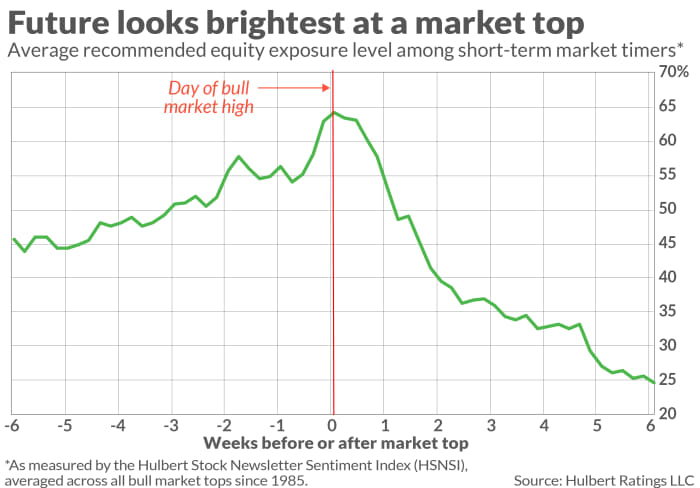Opinion: Why you won’t know it when a bear market starts
It was on Oct. 9, 2007, 14 years ago this week, that the stock market hit its bull market high prior to the beginning of the Financial Crisis-induced bear market.
I am willing to bet that the last thing on your mind that day was whether a new bear market was beginning. Instead, you undoubtedly were sharing in the exuberance that accompanied yet another new bull-market high. The S&P 500
SPX,
was 120% higher than where it had stood at the beginning of that bull market, five years previously.
And, yet, one of the worst bear markets in U.S. history was beginning on that very day. The S&P 500 over the subsequent 16 months would lose 55%.
This walk down memory lane is important because it serves as a reminder that bull market tops aren’t recognized in real time. It’s only after the fact that it becomes clear that the bull market has ended.
Many clients strenuously disagree with me about this, insisting that they in fact did have a good sense the bull market was topping out in October 2007. But they almost certainly are rewriting history, which is understandable. It’s human nature to rewrite the past to make it seem obvious that events would unfold as they did.
But the beginning of the 2007-2009 bear market was anything but obvious in the moment.
If you have any doubt, consider the average recommended equity exposure among a subset of nearly 100 short-term stock market timers my firm monitors on a daily basis. (This average is what’s represented by the Hulbert Stock Newsletter Sentiment Index, or HSNSI.) On average, the HSNSI reaches its highest level on the very day the bull market tops out.
This is illustrated in the accompanying chart. It averages the HSNSI over the six weeks prior and six weeks subsequent to every bull market top of the last 40 years (per the calendar maintained by Ned Davis Research). As you can see, the HSNSI rises 20 percentage points over the final six weeks of the average bull market, and then plunges 40 percentage points over the first six weeks of the subsequent bear market.

In other words, professional market timers on average are most optimistic on the very day they should be most pessimistic. They are professionals who follow the market all day, every day. If they can’t do better, then what makes you think you can?
Comments of market timers
I think these statistics make a compelling case. But to add anecdotal icing to the cake, consider a representative sampling of comments made by newsletter editors on the exact day of the October 2007 market top, or in the days immediately prior:
- …
Read More: Opinion: Why you won’t know it when a bear market starts
